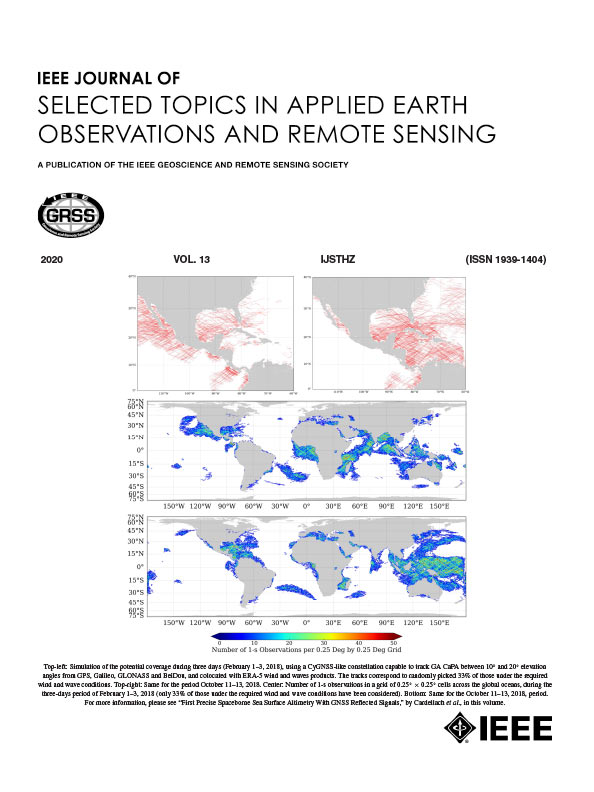Super-Resolution Reconstruction of SMOS Sea Surface Salinity from Multivariate Satellite Observations Based on Deep Learning
IF 5.3
2区 地球科学
Q1 ENGINEERING, ELECTRICAL & ELECTRONIC
IEEE Journal of Selected Topics in Applied Earth Observations and Remote Sensing
Pub Date : 2025-08-25
DOI:10.1109/JSTARS.2025.3602684
引用次数: 0
Abstract
Satellite sea surface salinity (SSS) observations play a critical role in the study of ocean circulation and climate regulation. However, mesoscale salinity dynamics (e.g., eddies, fronts) remain poorly resolved by current salinity satellites, such as soil moisture and ocean salinity (SMOS), due to their low effective resolution (>100 km). To address this, we proposed the SMOS SSS super-resolution reconstruction (S5R2) network. This deep learning framework achieved super-resolution (SR) reconstruction of the SMOS L3 SSS product from 1/4° to 1/12° by fusing multivariate satellite observations. Our approach integrated a land filtering mechanism into a hybrid transformer-CNN architecture, enhancing both global and local attention to ocean dynamics while suppressing interference from land-based information. Meanwhile, we improved the search efficiency of the optimal subset of input variables by guiding the search direction and step size using prior knowledge. The results demonstrated that S5R2 outperformed existing L3 and L4 satellite SSS products and mainstream SR algorithms. Compared to the input SMOS L3 SSS product, S5R2 achieved a 20% and 60% reduction in root mean square error in the Kuroshio Extension and Gulf Stream regions, respectively. In addition, it improved the effective resolution from 100 km to 20–30 km, enabling the dynamic tracking of mesoscale eddies. This advance provides a near-real-time solution for monitoring fine-scale ocean salinity processes, with practical implications for ocean dynamics research and the operational application of salinity satellite products.基于深度学习的多变量卫星观测SMOS海面盐度超分辨率重建
卫星海面盐度(SSS)观测在海洋环流和气候调节研究中起着至关重要的作用。然而,目前的盐度卫星,如土壤湿度和海洋盐度(SMOS),由于其有效分辨率较低(bbb100公里),对中尺度盐度动力学(如漩涡、锋面)的分辨率仍然很差。为了解决这个问题,我们提出了SMOS SSS超分辨率重建(S5R2)网络。该深度学习框架通过融合多变量卫星观测数据,实现了SMOS L3 SSS产品在1/4°到1/12°范围内的超分辨率(SR)重建。我们的方法将陆地过滤机制集成到混合变压器- cnn架构中,增强了对海洋动力学的全球和局部关注,同时抑制了来自陆地信息的干扰。同时,利用先验知识指导搜索方向和步长,提高了输入变量最优子集的搜索效率。结果表明,S5R2优于现有L3和L4卫星SSS产品和主流SR算法。与输入SMOS L3 SSS产品相比,S5R2在黑潮延伸区和墨西哥湾流区域的均方根误差分别降低了20%和60%。将有效分辨率从100 km提高到20 ~ 30 km,实现了对中尺度涡旋的动态跟踪。这一进展为精细尺度海洋盐度过程监测提供了接近实时的解决方案,对海洋动力学研究和盐度卫星产品的业务应用具有实际意义。
本文章由计算机程序翻译,如有差异,请以英文原文为准。
求助全文
约1分钟内获得全文
求助全文
来源期刊
CiteScore
9.30
自引率
10.90%
发文量
563
审稿时长
4.7 months
期刊介绍:
The IEEE Journal of Selected Topics in Applied Earth Observations and Remote Sensing addresses the growing field of applications in Earth observations and remote sensing, and also provides a venue for the rapidly expanding special issues that are being sponsored by the IEEE Geosciences and Remote Sensing Society. The journal draws upon the experience of the highly successful “IEEE Transactions on Geoscience and Remote Sensing” and provide a complementary medium for the wide range of topics in applied earth observations. The ‘Applications’ areas encompasses the societal benefit areas of the Global Earth Observations Systems of Systems (GEOSS) program. Through deliberations over two years, ministers from 50 countries agreed to identify nine areas where Earth observation could positively impact the quality of life and health of their respective countries. Some of these are areas not traditionally addressed in the IEEE context. These include biodiversity, health and climate. Yet it is the skill sets of IEEE members, in areas such as observations, communications, computers, signal processing, standards and ocean engineering, that form the technical underpinnings of GEOSS. Thus, the Journal attracts a broad range of interests that serves both present members in new ways and expands the IEEE visibility into new areas.

 求助内容:
求助内容: 应助结果提醒方式:
应助结果提醒方式:


